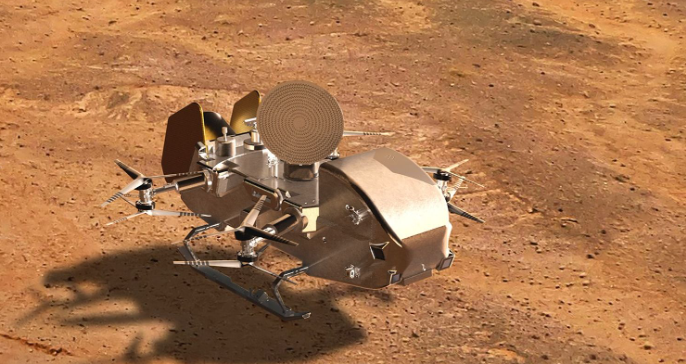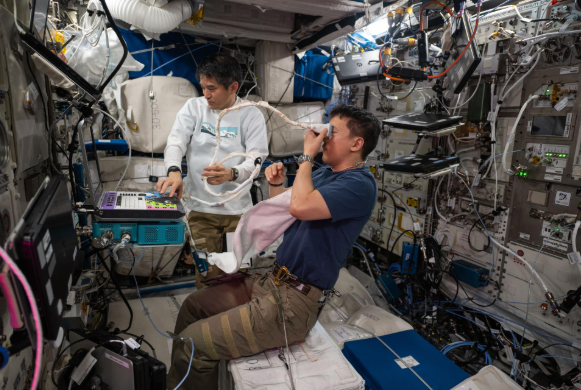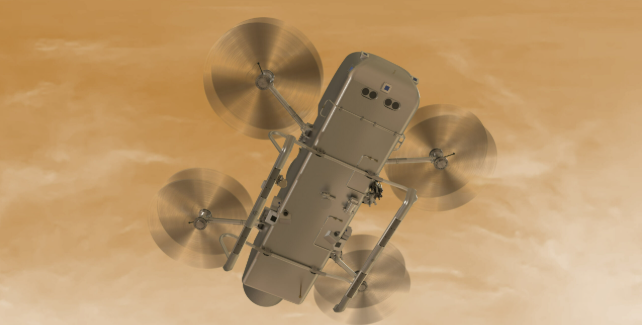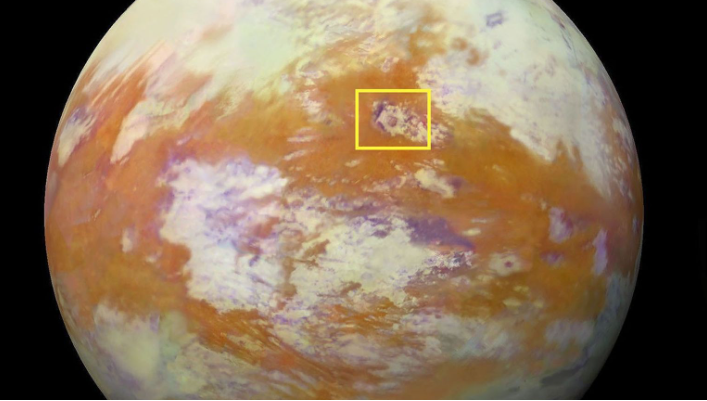Will NASA’s Dragonfly Mission Explore Titan’s World in 2028?
Space lovers would be excited to know about the Dragonfly Titan mission, which would be sent to Titan. Titan is Saturn's moon, a modern site with a comparable environment, with each day and night lasting around eight Earth days. NASA’s Dragonfly mission will explore Titan, Saturn’s largest moon, to investigate its potential for hosting life.
Titan’s dense, methane-rich atmosphere and Earth-like surface conditions make it a prime candidate for studying prebiotic chemistry similar to early Earth. The Dragonfly Titan mission might tell us about the chemistry that allowed life to exist on Earth over 4 billion years ago.

Why Titan? NASA’s Target for Alien Life
The Dragonfly mission would be sent to Titan to check the signs of life. There are the following reasons to target Titan:
Biggest Size
Titan is our solar system's second-biggest moon. It is bigger than the planet Mercury. It is around ten times farther from the Sun than Earth, at a distance of 1.4 billion km (886 million miles) as it circles Saturn.
Organic Molecules to Support Life
Titan has methane rivers and lakes on the surface, a subterranean ocean of liquid water, and even methane rain and clouds. The atmosphere of Saturn’s Titan forms more complex organic molecules, which fall like light snow. The Dragonfly will also use Titan's dense nitrogen-based atmosphere, which is four times denser than Earth's.
Temperature and Pressure
Titan’s surface temperature is around -290 degrees Fahrenheit (-179 Celsius) due to its extreme distance from the Sun. Additionally, its surface pressure is 50% greater than Earth's.
History of Titan Exploration: Cassini-Huygens Legacy
NASA added several Titan missions to its long-term priority list because of Cassini-Huygens's victory. While some of the older probe concepts were discarded, others received modifications. As NASA reexamined Titan mission concepts, it also reexamined the potential of uncrewed aerial vehicles.
In terms of Titan exploration, NASA's Dragonfly probe is the next phase of life research beyond the Earth. The Dragonfly mission will follow in the footsteps of the renowned Cassini-Huygens project. NASA and the European Space Agency carried out the Cassini-Huygens project. Cassini circled Saturn and its moons from 2004 until 2017. Huygens touched down on Titan in 2005. Together, the spacecraft explored Titan's atmosphere, surveyed the moon, and found signs of an ocean below the surface.
The Dragonfly spacecraft probe was developed as a result of the scientific realization that the 2000 Titan helicopter concept might be updated. In addition, the Ingenuity helicopter is a component of NASA's Perseverance mission to Mars. It proved that Dragonfly is feasible by demonstrating several successful autonomous flights.

Launch Date and Budget of the Dragonfly Mission
The Dragonfly rotorcraft mission to Titan, Saturn's organic-rich moon, has been confirmed by NASA. After getting permission for the mission to proceed to the final design stage, the whole spacecraft and science equipment will be built and tested.
Dragonfly Titan Mission’s Budget Overview
All of the mission's Preliminary Design Review success requirements were met in early 2023. In November 2023, this revised budget and timeline plan were submitted and given conditional approval. The approval was pending till the end of the fiscal year 2025. The president's budget proposal for fiscal year 2025 was released, confirming Titan Dragonfly's $3.35 billion lifespan cost and July 2028 launch date. Additionally, NASA approved more funds for a heavy-lift launch system to reduce the mission's cruise phase.
Timeline of Dragonfly Titan
The Dragonfly rotorcraft mission is scheduled to launch in 2028 and will reach Titan in 2034. The Dragonfly spacecraft will study Titan's many habitats throughout its 6-year baseline mission. It will visit hundreds of prospective moon regions in search of primordial chemical processes. These processes are typical of Titan and the early Earth before life evolved.
How Dragonfly Titan Will Fly: Rotorcraft Design & Technology
It may surprise you to learn how Dragonfly Titan is operated. Dragonfly will be able to fly because of Titan's dense atmosphere and low gravity. It is unlike planetary landers, which are often limited to exploring a single tiny area of the planet they visit.
Size of Dragonfly Spaceship
The Dragonfly spaceship is roughly the size of a compact car, with four arms that each support two helicopter rotors piled on top of one another. This design will enable it to fly briefly across the surface. Light will take more than an hour to go to Titan in one direction, so each flight must be carefully pre-programmed due to long communication delays with Earth.
Power Source
Sunlight is just 1% as powerful on Saturn as it is on Earth because of its distance from the Sun. Most of the rest is blocked by Titan's cloud. The Dragonfly mission will function on batteries during the day and recharge at night via a nuclear power source, like those utilized by NASA's Curiosity and Perseverance rovers.
Multirotor Vehicle
The Dragonfly mission is the first time NASA will fly a multirotor vehicle for science on a different planet with its whole research payload for repeated and focused accessibility to surface materials. The rotorcraft resembles a large drone and features eight rotors, known as the Dragonfly Drone Titan.
Flight of Dragonfly
Dragonfly is an 8-bladed rotorcraft. It will be capable of flying once every Titan day. Titan's gravity is less than that of our moon, at around one-seventh of Earth's. The circumstances are ideal for flying since the atmosphere is four times denser than Earth's. Dragonfly Titan will experience the pressure a meter below the surface. In other words, you could fly if you put on some wings and flapped your arms!

Scientific Instruments of the Dragonfly Titan Mission
NASA’s Dragonfly mission will investigate Titan's surface everywhere it travels. It will need to gather organic compounds precipitating from the atmosphere.
- A drill that grinds up materials to be vacuumed into a device known as a mass spectrometer is attached to each of the probe's two sled-like tracks. The mass spectrometer will measure the molecular mass of every sample. It will include the heavier organic components that make up life.
- Additionally, Titan’s Dragonfly is equipped with a set of equipment that will directly examine Titan's atmosphere. It will enable researchers to examine how Titan’s atmosphere varies with the seasons and days. It might aid in our comprehension of the formation of Earth's atmosphere.
- The Dragonfly spacecraft will use a seismometer to measure any Titanquakes.
- The Dragonfly rotorcraft is equipped with cameras to capture aerial photos when it flies over Titan's sky. These images will aid the mission team in scouting for Dragonfly's future destinations. The image of the Titan will provide the incredible panoramas of this enigmatic moon.
Dragonfly Titan and Astrobiology: The Search for Life
Dragonfly Titan's mission equipment will aid in astrobiology. They help us understand how life’s building blocks may have formed on other worlds. These astrobiological phenomena are thought to be comparable to Earth before the emergence of life.
The moon's atmosphere and surface characteristics, subsurface ocean, and liquid reserves will also be examined by the Dragonfly mission equipment. The researchers will also explore the regions where water and complex organic components formerly coexisted for maybe many thousands of years, as these two molecules are essential to life.
When Will Dragonfly Reach Titan?
NASA's Dragonfly is scheduled to launch in 2028 and arrive in 2034. It will investigate the elements that make up life by sampling and analyzing hundreds of intriguing locations surrounding Saturn's frozen moon.
Why Titan Has an Atmosphere and Other Moons Don’t
The question, like “Why is Titan the only moon in the solar system with a significant atmosphere when there are other moons of similar size?” may arise in your mind.
Models of the solar system indicate that many massive moons once had atmospheres. However, because Ganymede is nearer the Sun than Titan, its atmosphere eventually lost molecules due to solar radiation, leaving behind the mostly naked disk of ice that we see today. Titan was too frigid to suffer the same fate, and it may have an atmosphere to support life. The Dragonfly Titan mission will work on the chances of life on Titan.


Be the first to write a review!